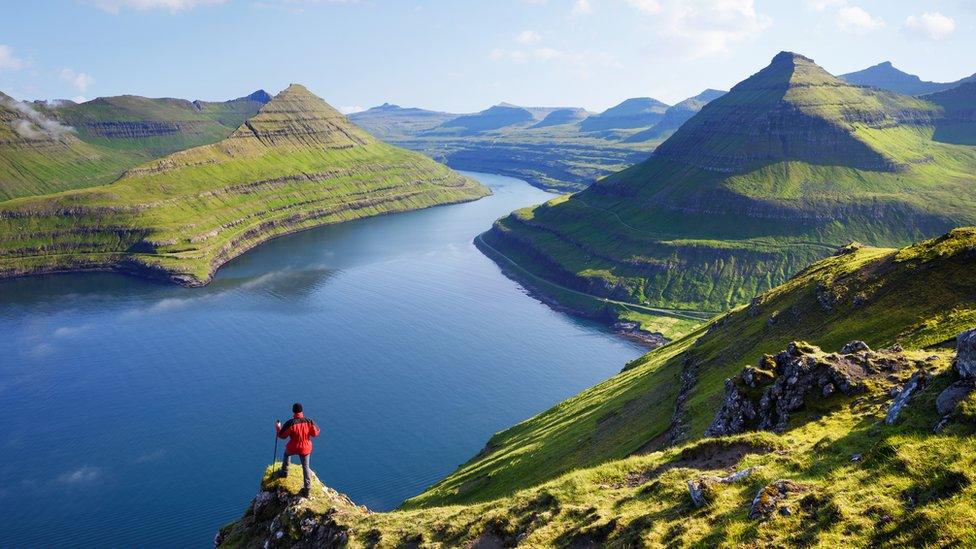British or Irish reached remote Faroe Islands before Vikings
- Published

The rugged Faroe Islands were settled by 500AD, hundreds of years before the earliest known Viking arrival
People from Britain or Ireland may have reached the remote Faroe Islands before the Vikings, according to new evidence.
Historically, the North Atlantic archipelago was part of the Viking world and its inhabitants speak a language derived from Old Norse.
Now, evidence has emerged that people reached the island by 500 AD - some 350 years before Scandinavians arrived.
This early settlement pre-dates the adoption of long-distance sailing technology by the Vikings.
Researchers found fragments of sheep DNA and chemical residues of sheep faeces in lake sediments on the Faroese island of Eysturoy. These were assigned an age using scientific dating techniques. Livestock could only have reached the remote archipelago if they were taken there by humans on boats.
"You see the sheep DNA and the biomarkers start all at once. It's like an off-on switch," said Dr William D'Andrea, from the Lamont-Doherty Earth Observatory (LDEO) at Columbia University in New York.
Lead author Lorelei Curtin, who worked on the research while she was a graduate student at LDEO, said the findings were the "nail in the coffin" for the idea that the islands were uninhabited until the 800s.
The scientists say these new results provide "unequivocal" evidence of a human presence before the Vikings arrived in the 9th Century AD. Furthermore, several indirect lines of evidence suggest an earlier occupation of the Faroes by Celtic-speaking people from Britain, Ireland or both.
Dr D'Andrea told BBC News: "We still really don't know who the people were and why they chose to go to the Faroe Islands. But there are lots of pieces of information that lead us to believe it is very likely there was a population of people from the British Isles."

Important archaeology probably lies underneath existing settlements such as the capital Tórshavn
These other clues include ancient, but undated, Celtic grave markers that dot the islands, Celtic place-names, historical accounts and DNA evidence from people living on the islands - which are located about halfway between Norway and Iceland.
According to Medieval texts, the early Irish navigator St Brendan set out across the Atlantic with comrades from 512 to 530, and supposedly found a land dubbed the Isle of the Blessed. Later, in 825 AD, the Irish monk Dicuil wrote that some northern islands had been settled by hermits for at least 100 years.
Many have speculated that these accounts refer to the Faroes, but there is no conclusive proof. And there are controversies over other lines of evidence.
Some scholars argue that Celtic place names needn't be a sign of pre-Norse settlers. Instead, they submit, there was already extensive contact between the Vikings and populations in Britain and Ireland by the 9th Century AD - so Celtic speakers could have travelled with the Norse on their boats.
DNA evidence shows that people who live on the islands today derive most of their paternal ancestry from Scandinavians, but most of their maternal ancestry comes from British or Irish people, external. This pattern, of Celtic women having children with Scandinavian males, is seen in Iceland too and has previously been interpreted as a hallmark of Vikings transporting non-native women on their voyages.

The imposing Risin og Kellingin sea stacks lie off the northern coast of Eysturoy
But it's also consistent with a scenario where the islands were populated when the Norse arrived, and the authors point out that the proportion of British or Irish ancestry is much higher in the Faroes than in Iceland.
Despite the incredible achievements of Norse mariners, it's thought the sail was adopted in Scandinavia between 750 and 820 AD - late compared with other parts of Europe. This makes it unlikely that they could have reached the Faroes by the early 6th Century.
Dr D'Andrea and his colleagues had originally set out to better understand the climate at the time that the Vikings arrived on the Faroes. They had been using a boat to extract sediment cores from a lake near the village of Eiði, the site of an ancient Viking locale on Eysturoy.
Starting at 51cm (20ins) down in the sediments, they detected the sudden arrival of livestock, most likely some time between 492 and 512, but possibly as early as 370.
A layer of ash deposited from a known Icelandic volcano eruption in 877 helped them reliably date the sediment sequences below.
Another team of researchers had previously found barley grains on the Faroese island of Sandoy, external, dating to between 300 and 500 years before the Norse period.
Kevin Edwards, from the University of Aberdeen, who was a co-author of the barley paper, said the new study "has produced convincing and exciting evidence" of earlier occupation.
He added: "Is similar evidence to be found in Iceland, where similar arguments are made for a pre-Norse presence, and for which tantalisingly similar archaeological, pollen-analytical and human DNA are forthcoming?"
The research was funded by the US National Science Foundation and involved researchers from LDEO, the College of William & Mary, the University of California, Santa Cruz, University of Massachusetts, Amherst and the University of Bergen in Norway.
The findings have been published in the peer-reviewed journal Communications Earth and Environment., external
Follow Paul on Twitter., external